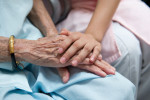Study Reveals Nursing Home Injury Statistics on Hip Fractures
 When nursing home residents fall and experience a hip fracture, they are more likely to die or become totally disabled within six months, according to a recent nursing home injury study conducted by researchers at the University of Pennsylvania. The study was published on June 23 by the medical journal, JAMA International Medicine.
When nursing home residents fall and experience a hip fracture, they are more likely to die or become totally disabled within six months, according to a recent nursing home injury study conducted by researchers at the University of Pennsylvania. The study was published on June 23 by the medical journal, JAMA International Medicine.
Researchers from the Perelman School of Medicine found that one out of every three nursing home residents who fall and fracture their hip die within six months after being hospitalized.
The data was gathered from Medicare and nursing homes on more than 60,000 long-term care nursing home residents hospitalized after sustaining hip fractures between 2005 and 2009. Most of the residents had complete mobility prior to suffering the life-changing fall.
Nursing home injury
Half of the residents who suffered a hip fracture were permanently disabled and had experienced diminished mobility and one-third had died ─ including nearly half of the injured male residents ─ six months following their hip fracture.
Close to half of the residents who had experienced a hip fracture had died after a year.
When patients were not hospitalized after suffering the fracture ─ especially those over age 90 ─ their chance of permanent injury or death increased.
Results also indicated “marked decreases” in a number of essential life activities, including dressing, eating and bathing.
“Survival and functional outcomes are poor after hip fracture among nursing home residents, particularly for patients receiving non-operative management, the oldest old, and patients with multiple comorbidities and advanced cognitive impairment,” the researchers resolved. “Care planning should incorporate appropriate prognostic information related to outcomes in this population.”
Under current regulations, nursing home personnel is required to take action to protect residents against these types of injuries. Facilities are required by law to complete an assessment when a resident enters a facility, to reduce the risk of falls and other injuries. The assessment includes a description of the physical capabilities of the resident to assess their chances of falling. Following this evaluation, proper steps must be taken to ensure the resident receives the necessary care to prevent a fall.
Percentage of residents not receiving surgery nearly doubles
Compared with a 2010 study published in the official journal of the American Public Health Association, the percentage of nursing home residents with hip fractures who didn’t receive surgery nearly doubled to approximately 12%. The reason fewer residents are receiving surgery for these types of injuries is unknown.
Approximately one in five senior citizens not living in a nursing home dies within a year following a hip fracture.
A hip fracture is typically very painful. Doctors often advise patients to undergo surgery to help alleviate the pain ─ even very elderly people who ordinarily would not opt to endure a major procedure.
Surgeons typically believe it is best to operate on hip fractures as quickly as possible following the incident. However, with older patients extra precautions often need to be taken to confirm their safety and maximize their health prior to surgery, which may take additional time.

